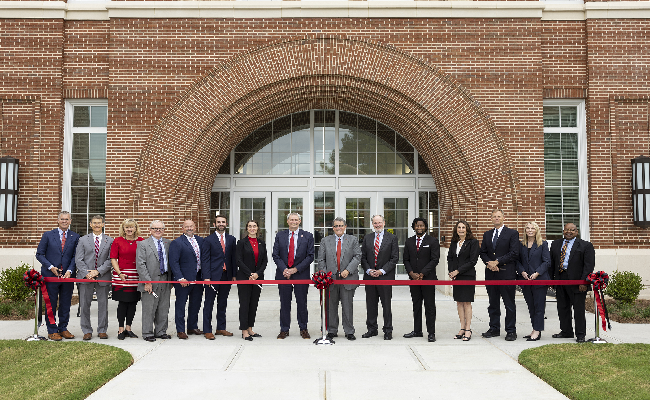 $64 million building will support collaborative research across scientific disciplines
$64 million building will support collaborative research across scientific disciplines
Athens, Ga. – The University of Georgia held a ribbon-cutting ceremony to celebrate the completion of the second phase of the Interdisciplinary Science, Technology, Engineering and Math (I-STEM) Research Complex on Wednesday, Aug. 24.
The 101,000 square foot, $64 million I-STEM Research Building 2, which was funded by a combination of university and state funds, will support collaborative research in chemistry, engineering and other scientific disciplines.
Paired with Building 1, which opened last fall, the completed I-STEM Research Complex adds more than 200,000 square feet of new space for research and instruction.
“The completion of this facility brings us a step closer to fulfilling a multi-year capital plan to build, renovate and modernize hundreds of thousands of square feet devoted to research and innovation on our campus,” said UGA President Jere W. Morehead. “We are very grateful for the strong support of the Governor, the Georgia General Assembly and the Board of Regents which made this project possible.”
Franklin College of Arts and Sciences Dean Alan Dorsey, College of Engineering Dean Donald Leo and student speakers Lori Estes Bright and Christian Freeman addressed the audience, which included Sen. Frank Ginn, Rep. Houston Gaines and Rep. Marcus Wiedower.
“The discipline of engineering really exists at the interface of the basic sciences and the technologies and practices that improve our world. And the I-STEM research buildings embody that ideal,” Leo said. “I-STEM phase two has already helped us attract some of the best and brightest faculty and students to UGA.”
The building features three levels of flexible, open lab space as well as an 88-seat classroom. It will be home to dozens of faculty and graduate students working in STEM fields.
In addition to the new I-STEM building, the university is modernizing existing facilities on South Campus, including the original Chemistry Building and the Biological Sciences Building, to support the institution’s growing research enterprise.
“As we celebrate the newest I-STEM research building and the collaborative learning and spirit of discovery it represents, we are elated about where the work inside this great facility will take us next,” Dorsey said. “It’s a new view from this spot on our campus. A view not fixed in a geographical direction per se, but toward a future we can imagine with the progress and improvements of cures, new products, new materials and new knowledge.”
Those attending the ceremony were invited to take a self-guided tour of the new facility, where students and staff from the Franklin College and the College of Engineering provided information about research projects taking place in the labs.
Bright, a doctoral student in biomedical engineering from Canton, Georgia, told the audience how the I-STEM Building 2 will support her research on medical device materials that reduce the risk of infections and blood clots.
“As an engineering graduate student at UGA, I get to work with polymer chemists, microbiology specialists and tissue culture and virology experts, who each hold a unique and invaluable perspective on the problems that we face, leading us to develop more effective solutions,” Bright said. “And now we have a space that allows those collaborations to not only continue but to expand.”
Freeman, a doctoral student in analytical chemistry from Conyers, Georgia, works in a lab that relocated to I-STEM Building 1 last year. He studies the role of cell membranes in the development of antibiotic resistance to increase the effectiveness of antibiotics in the future.
“This type of research requires a lot of room, and thanks to the space available in STEM-1, we’ve been able to create a dedicated workflow to facilitate our research,” Freeman said. “With its instrument venting system, customizable lab spacing, functioning in-house gases, countless integrated fume hoods, expansion of complex instrument use, and collaboration space, this facility will help students and faculty accomplish amazing feats in research.”
Contact: James Hataway, jhataway@uga.edu


